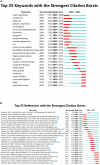Research status and global trends of late-life depression from 2004 to 2023: bibliometric analysis
- PMID: 38752209
- PMCID: PMC11095109
- DOI: 10.3389/fnagi.2024.1393110
Research status and global trends of late-life depression from 2004 to 2023: bibliometric analysis
Abstract
Background: Global research hotspots and future research trends in the neurobiological mechanisms of late-life depression (LLD) as well as its diagnosis and treatment are not yet clear.
Objectives: This study profiled the current state of global research on LLD and predicted future research trends in the field.
Methods: Literature with the subject term LLD was retrieved from the Web of Science Core Collection, and CiteSpace software was used to perform econometric and co-occurrence analyses. The results were visualized using CiteSpace, VOSviewer, and other software packages.
Results: In total, 10,570 publications were included in the analysis. Publications on LLD have shown an increasing trend since 2004. The United States and the University of California had the highest number of publications, followed consecutively by China and England, making these countries and institutions the most influential in the field. Reynolds, Charles F. was the author with the most publications. The International Journal of Geriatric Psychiatry was the journal with the most articles and citations. According to the co-occurrence analysis and keyword/citation burst analysis, cognitive impairment, brain network dysfunction, vascular disease, and treatment of LLD were research hotspots.
Conclusion: Late-life depression has attracted increasing attention from researchers, with the number of publications increasing annually. However, many questions remain unaddressed in this field, such as the relationship between LLD and cognitive impairment and dementia, or the impact of vascular factors and brain network dysfunction on LLD. Additionally, the treatment of patients with LLD is currently a clinical challenge. The results of this study will help researchers find suitable research partners and journals, as well as predict future hotspots.
Keywords: CiteSpace; bibliometric analysis; cognitive impairment; dementia; global trends; late-life depression.
Copyright © 2024 Du, Yang, Li, Wang and Cai.
Conflict of interest statement
The authors declare that the research was conducted in the absence of any commercial or financial relationships that could be construed as a potential conflict of interest.
Figures







Similar articles
-
Bibliometric and visual analysis of transcranial direct current stimulation in the web of science database from 2000 to 2022 via CiteSpace.Front Hum Neurosci. 2022 Dec 1;16:1049572. doi: 10.3389/fnhum.2022.1049572. eCollection 2022. Front Hum Neurosci. 2022. PMID: 36530203 Free PMC article.
-
Knowledge domain and trends in treatment-resistant schizophrenia (TRS) research based on CiteSpace bibliometrics analysis.Front Pharmacol. 2024 Nov 5;15:1478625. doi: 10.3389/fphar.2024.1478625. eCollection 2024. Front Pharmacol. 2024. PMID: 39564115 Free PMC article.
-
Trends of mitochondrial changes in AD: a bibliometric study.Front Aging Neurosci. 2023 May 16;15:1136400. doi: 10.3389/fnagi.2023.1136400. eCollection 2023. Front Aging Neurosci. 2023. PMID: 37261264 Free PMC article.
-
Global research status of anterior cruciate ligament reconstruction: a bibliometric analysis.EFORT Open Rev. 2022 Dec 21;7(12):808-816. doi: 10.1530/EOR-21-0065. EFORT Open Rev. 2022. PMID: 36541554 Free PMC article. Review.
-
Research trends and hotspots of post-stroke cognitive impairment: a bibliometric analysis.Front Pharmacol. 2023 May 30;14:1184830. doi: 10.3389/fphar.2023.1184830. eCollection 2023. Front Pharmacol. 2023. PMID: 37324494 Free PMC article. Review.
References
Grants and funding
LinkOut - more resources
Full Text Sources

